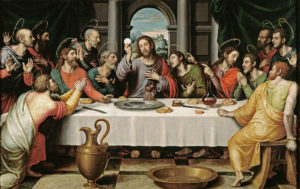Thoughts on Today’s Lessons for April 9, 2017
Liturgy of the Palms A
Gospel: Matthew 21:1-11Palm Sunday and Passion Sunday, once celebrated separately, now fall together at the beginning of Holy Week. This can give us an emotional jolt as we hear Jerusalem’s crowds celebrating Jesus as Messiah and King in the Gospel of the Palms, then hear them shouting “crucify him!” in the Gospel of the Passion. First, excited crowds surround Jesus, shouting praise and waving palm branches as he rides into the city to loud hosannas. But before long he will anger the authorities as he drives the money-changers out of the temple. After that it doesn’t take long for him to be arrested, mocked, flogged and crucified.
Appropriately for Palm Sunday, we sing this Psalm, an ancient hymn that also depicts a festive procession in honor of our righteous and merciful Lord and God. In familiar words we sing of “the day that the Lord has made” and envision a Messiah as we remember the stone that the builders rejected that became the cornerstone.
Liturgy of the Passion A
First Reading: Isaiah 50:4-9a
When Christians hear Isaiah’s verses about the “suffering servant,” our thoughts naturally turn to Jesus Christ, our messiah and king. Our Creeds declare that Jesus suffered for us. Our Gospels reveal a Jesus who taught us to turn our cheeks to those who strike us, knowing that a peaceful response to enemies is no cause for disgrace. As we go through Holy Week, though, let’s remember that Isaiah was not writing to Christians in a future time but to a Jewish audience in his own time, living in exile in Babylon, a suffering body of faithful servants, hoping for a Messiah to guide them home.
Perhaps the Psalmist who wrote this ancient hymn had Isaiah’s Suffering Servant in mind with these verses of lament. We might think of Job, too, as we chant this litany of sorrow, distress, grief, sighing, misery, scorn, horror, dread and more. While we suffer, our neighbors scheme; they even plot our death. And yet, with faith in God, hope still glows for us like the sun breaking through clouds: We trust in God’s love, and wait to be saved.
Second Reading: Philippians 2:5-11
These poetic verses are thought to come from an early Christian hymn. They remind us of the “suffering servant” as we imagine a Jesus who was fully divine, yet willing to set aside his divinity – “emptying himself” – to bear the unimaginable pain of crucifixion as a vulnerable, frightened human. Jesus accepted the full weight of that suffering to show us the true exaltation of God’s love, asking only that we respond with love for God and our neighbor.
Gospel: Matthew 26:14 – 27:66
And now the direction of today’s readings reaches its conclusion in Jesus’ passion and death. We hear almost two full chapters of Matthew’s Gospel to take us through Christ’s long journey from the Last Supper to the crucifixion. For now, let’s reflect on one particular point: When Jesus told the apostles that one of them was going to betray him, they all lacked confidence in their faith. Every single one of them wondered if he might be the traitor. Each in turn asked, ‘Surely not I, Lord?” Like the apostles, even if we believe our love is strong, we worry inside. Like the apostles, we know that we are human: frail and weak. And Jesus, loving us still, takes up the cross.

